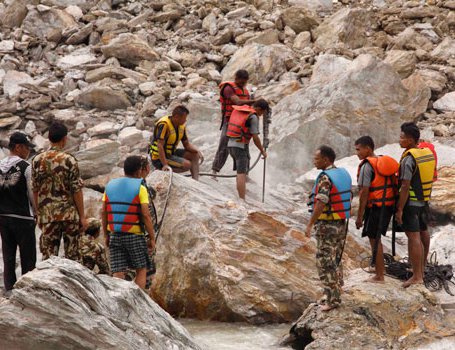
Nepal’s vulnerability
Nepal lies in the central part of the Himalayan belt. Because of its location characterized by a rugged topography, very high relief, variable climate conditions, complex geographical structures with active tectonic processes and continued seismic activities, Nepal is prone to natural disasters. Obviously, the country requires a strong coping strategy and DRM to minimize the negative effects of natural disasters. But various human interventions have hastened the occurrences of natural disasters. Due to this, the vulnerable groups, mainly the poor and the marginalized people from the rural and urban areas, are facing economic hardships and bearing all kinds of burden. Insufficient knowledge on DM, emerging climate risks, low literacy rates, inadequate physical infrastructure, poor forecasting facilities and unplanned settlements have worsened the situation. Frequent problems related with the livelihoods have hit the vulnerable people the most. Agriculture is the hardest hit sector.
Several studies have also shown that Nepal is exposed to a multitude of hydro-meteorological hazards, including floods, landslides, droughts, windstorms, hailstorms, cloudbursts, fires and epidemics. Of the 75 districts, 49 are prone to floods and/or landslides, 23 to wildfires, and one to windstorms (NDR, 2009). According to one study, Nepal is ranked the fourth most vulnerable country in the world in terms of climate change-induced hazards. A survey of 200 countries ranks Nepal in the 11th and the 30th places as the most vulnerable country in terms of earthquakes and floods respectively. The records between 1971 and 2010 reveal that climate-related disasters accounted for almost 25% of deaths, 84% affected by disasters, and 76% suffered economic losses. In the last 20 years, properties worth over USD 288 million, or about USD 23 million a year, have been lost.
Disasters are a serious impediment to Nepal’s development and have undermined its development efforts at poverty alleviation and their gains. Any major disaster can easily sweep out the success Nepal has gained in the Millennium Development Goals (MDGs) because it will hit the poor and the disadvantaged the hardest. Despite having policies, laws, institutional mechanisms and capabilities, Nepal is yet to manage disasters properly. Nepal is yet to link DRM into its national development projects and periodic five and three years’ planning. There is a wide gap in gender involvement and effective use of early warning system. Due to impacts of climate change, Nepal seems to be heading from a bad to worse situation.
Recent Disasters
Nepal is one of the 20 most disaster-prone countries in the world. The data on human mortality for the period 1971-2007 show more than 27,000 deaths, 50,000 injuries, 3,000 missing and approximately 5 million affected people. More people are killed by disasters in Nepal than in any other country in South Asia.
Due to heavy and continuous rainfall all over the country in the last two weeks of August, disaster became a national agenda from, stirring debates from grassroots level to the parliament. The landslides and floods started from Jure VDC of Sindhupalchok and Sunkoshi and after that, due to continuous rain, reached in different districts of Midwestern to Far- western regions of Nepal. The highly impacted districts of this region are Bardiya, Shurkhet, Dang, Banke, Jajarkot, Kailali, Kanchanpur and other parts of the country. Many people died, more injured and some of them are missing and about 20,000 are displaced. The major infrastructure of Babai Irrigation Project and some parts of the Sikta Irrigation were swept away and billions rupees worth of property was damaged. Floods affected people are crying, weeping, and shouting for the help for their livelihood support. Many people are in the street without any shelter and food. The situation seems to be very panicky. But this is not the first time the country has been affected by landslide, floods, riverbank cutting and others natural disaster. In the past also, a number of such incidents had happened. In September 2011, an earthquake measuring 6.9 Richter scale devastated the eastern parts of Nepal with the losses crossing an estimated 4 billion rupees. Similarly, the breaking of the Koshi embankment caused a massive damage to lives and properties in the eastern parts in 2008. The flash floods of 2009 in Kailali and Kanchanpur and landslides in Doti and Accham districts damaged infrastructure and properties of worth billions of rupees. The epidemic in Jajarkot and Rukum districts in 2009 also killed a number of people. According to a study, during the period between 1971-2010, more than 50,000 people were reportedly injured and more than 27,000 reportedly died.
The government has declared a national crisis, formally recognizing the humanitarian crisis caused by massive landslides and flooding. The parliamentary session has also been adjourned for a week. A total of 24 districts have been seriously affected by the flooding and landslides triggered by incessant monsoon rainfalls for one week. The government took various decisions under the Chairmanship of Deputy Prime Minister, who is also the chairman of Central Disaster Relief Committee for coordination, relief, rescue and rehabilitation. The opposition parties in the Parliament criticized the government for not taking the natural disasters seriously and not providing relief packages to the victims. The government has requested the parliament to form a high level committee under the chairmanship of Prime Minister, with the leader of opposition party also in it. It shows that the government is serious about tackling the issue of disaster.
Emergency Preparedness Mechanisms
The Ministry of Home Affairs (MOHA) is a key ministry and a nodal agency for disaster management, including the emergency preparedness mechanism at the central level. The MOHA governs disaster management initiatives. There are also related regional level bodies and District Natural Disaster Relief Committees (DNDRCs). They hold stakeholders meetings to develop preparedness plans. However, there are no disaster cells within them. There is a Central Disaster Relief Fund at the central level and its offices at the district level as well. There are also Central Natural Disaster Relief Committees and District Disaster Relief Committees. The Prime Minister’s Relief Fund is at the top. Given Nepal’s present state, the Village Development Committees (VDCs) do not have access to the funds. There is always a controversy in Damage and Needs Assessment at times of disaster. Institutions working in the sector lack coordination. According to Natural Disaster Relief Act 1982, there is a provision of a Central Natural Disaster Relief Committee chaired by the Minister of Home Affairs at the central level followed by Regional District Relief Committees at the Regional Level and District Disaster Relief Committees at the District Level to coordinate the relief and rescue operations. Nepal Army, Nepal Police and Armed Police are primarily responsible for these operations. Nepal Red Cross society has been providing relief materials.
The emergency response mechanisms are poor at the district as well as grass root levels. Due to the one door policy of the DDRCs, rescue and rehabilitation often get delayed during the emergency response. There is a similar situation at the central level. Relief efforts are often duplicated because of the limited effectiveness of the coordination mechanism between disaster actors and government agencies or because of lack of such a mechanism. That is where there is the need of a policy level intervention.
Although National Emergency Operation Center is established under MoHA to coordinate the emergency response services and new legislation, which is hugely focused on DRM in the present context, it is in the process of finalization. This shows there is still a long way to go to make emergency preparedness mechanism more effective.
Policy frameworks
Nepal does not lack policy frameworks in disaster management. Natural disaster relief committees exist at three different levels. However, they don’t have clear roles and responsibilities. Past experiences have shown that the regional level bodies are non-functional and policy provisions for village level NDRCs are lacking. DDRCs are widely acknowledged by various actors but their bureaucratic nature creates hurdles in the course of rescue and rehabilitation. The requirement for approval from DDRCs to start the rescue work discourages early action. Although the Local Self Governance Act 1999 gives local bodies the authority and responsibility to design and implement disaster responses, no budget is allocated to them. Although National Strategy for Disaster Risk Management in Nepal 2009 sets a road map of where Nepal intends to be by 2015-the deadline for the Hyogo Framework of Action (2005-2015 and MDGs), the government policies have yet to back it. The government has adopted the National Strategy for Disaster Risk Management 2009 based on Hyogo Framework for Action. This new strategy includes prevention, mitigation, preparedness, response and recovery. The three-year Interim Plan 2010-2013 also highlights the DRR. However, the much talked about new Disaster Bill is yet to be tabled in the parliament.
Existing capacity
Along with District Natural Disaster Committee (DDRC), Nepal Army, Nepal Armed Police, Nepal Police, DDCs, Municipalities, VDCs, various other government offices, CBOs and NGOs have been working in DRM but they lack the capacity of responding. Existing response mechanisms are neither timely nor adequate in terms of resources to deal with disasters. The literature shows that the delay in action creates many problems, including trouble for disaster affected people. As there is a lack of one accountable agency or specific policy for undertaking search and rescue, everything is done on an ad-hoc basis. Nepal’s disaster response is still based on rescue and nobody really thinks about rehabilitation and other human parts. More complicated parts of disaster are in rehabilitation, which is tedious and time consuming.
Coordination mechanisms and its effectiveness
Several years of efforts and lessons have singled out the absence of an effective coordination mechanism as a major problem in dealing with disasters. The established mechanism and effectiveness is always lacking. Disasters involve many institutions at local and national levels but when the need arises, the absence of institutions is always felt in rescue and rehabilitation. International actors also get involved in some cases but they are more focused on policies rather than to help the needy.After disasters, the CDRC organizes meetings with government line ministries and bilateral organizations to arrange for resource mobilization and management, plans of actions and to share situation updates, and DDRCs execute the EPR work, but oftentimes, one or the other party goes out of step. Despite invoking public private partnership in times of disaster, it is yet to work, showing the need to make public private initiative strong and the role of DDCs and municipalities wider.

Purushotam Ghimire
Mr. Ghimire, Former Joint Secretary, Expert/Resource person of CC, DRR, SDGs, participates in the climate discussion at the national and international level. He could be contacted via his email: purughimire@yahoo.com, or gihimirep@gmail.com
- Opportunities For Synergistic Climate Response
- Oct 27, 2017
- Disaster Risk Reduction: Words And Actions
- Nov 22, 2014
- Mainstreaming Disaster In National Development
- Sep 26, 2014
- Managing Disaster Risk And Climate Change
- Sep 11, 2014
- Post 2015 Agenda: MDGs Plus to SDGs
- Aug 17, 2014












